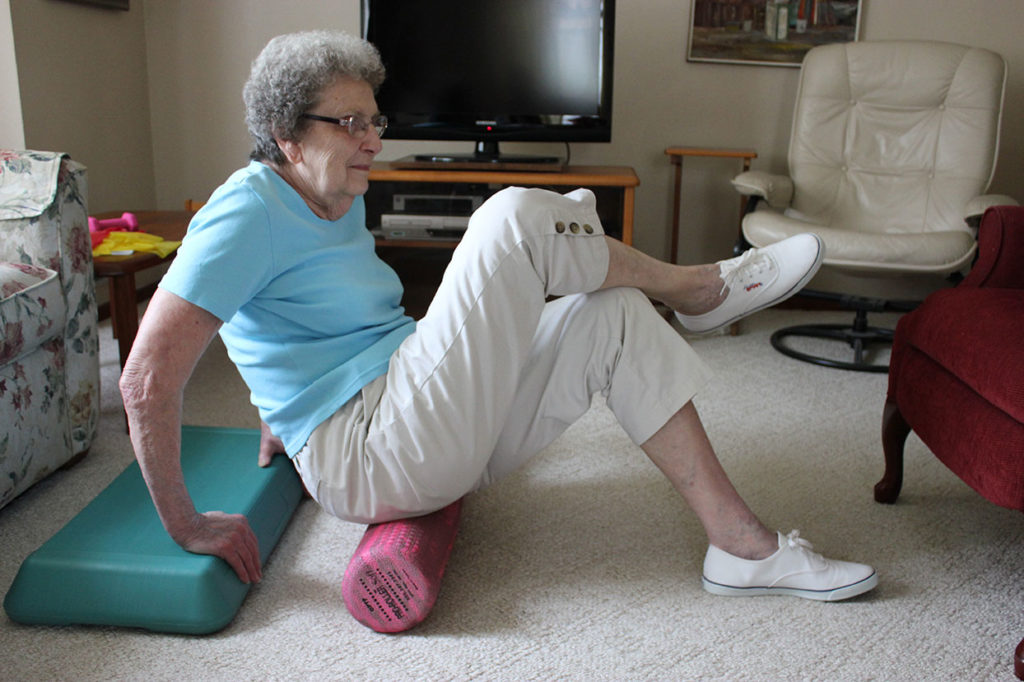Self Myofascial Release Without the “Ouch!”

The condition of our connective tissue depends on two factors—how old we are and what we have done in our lives to keep our tissue healthy, hydrated and flexible.
The health of connective tissue is a serious concern for older people [and can be for other vulnerable populations], as movement restrictions caused by poor tissue health can make it hard to perform simple activities of daily living. While personal trainers often develop flexibility programs and modify exercises to help senior clients succeed, there is another valuable technique to improve seniors’ range of motion.
That technique is self myofascial release, or SMR, which works with clients of all ages and simply needs to be modified for older adults to address the physical changes of aging. For example, a typical SMR technique for the hamstrings involves resting the backs of the thighs on a foam roller and using the upper body to pull the legs across the roller. This works fine for clients with strong upper bodies, good core strength, adequate wrist flexibility and good shoulder stability, but it is not a viable option for many older adults.
SMR Techniques for Older Adults
The goal of SMR with older adults is to rehydrate fascia and “unstick” collagen fibers. SMR is based on the concept that connective tissue is interspersed with mechanoreceptors that respond to external pressure, creating potential for preventive and therapeutic interventions (S├Âlch 2013).
Effective self-myofascial-release work combines pressure and movement. SMR is often done with a firm roller that can be moved across sections of the body to help “release” the myofascial tissue below the skin. Research suggests that using a rigid roller and applying strong pressure to an isolated contact area can be helpful for younger exercisers (Curran, Fiore & Crisco 2008). Senior clients with fragile tissues and bony structures have much more potential for injury, however, so trainers need to adjust their methods, favoring lighter pressure over a wider contact area and using a soft foam roller.
Applying too much pressure causes muscle contractions that affect fascia and restrict the effectiveness of SMR, according to Dana Rutt, a certified sports massage therapist at Podium Sports Therapy Massage in Minnetonka, Minnesota. The key is applying just enough pressure—similar to the amount used when kneading bread—so the muscle remains pliable, and making sure movements are slow and controlled.
Modifications for Older Exercisers
Trainers need to modify SMR techniques to account for weakness, injuries and chronic conditions. SMR should not be used with clients experiencing the inflammatory phase of an autoimmune disease such as rheumatoid arthritis or lupus. Be cautious with clients who take blood-thinning medications, and watch for bruising.
Bones of the rib cage and spine may be fragile because of osteoporosis or osteopenia. To avoid the risk of fractures, use one or two fingers in the spaces between the ribs for SMR techniques on the chest; use a soft ball or roller with light pressure when working in the midback region.
SMR techniques require clients to push or apply force to an area of the body, increasing blood pressure. Instruct clients to breathe normally throughout the movement. They should feel an “Ooohh” as they perform an exercise, not an “Ow!”
Be careful with techniques that require the head to be lower than the heart. Check for signs of dizziness, and stop the exercise if it occurs.
When possible, perform SMR in a seated position. On a floor or bench, accommodate limitations by using cushions to support joints. Small malleable balls and soft foam rollers can provide adequate pressure. For midback work, place a ball in a sock to allow for easier placement.
SMR Exercises
Start SMR with the hands and feet. Tightness in the feet and hands may be the source of pain in the knees and hips or shoulders and neck.
For sample exercises, please see “Seniors and Self Myofascial Release” in the online IDEA Library or in the October 2014 print issue of IDEA Fitness Journal. If you cannot access the full article and would like to, please contact the IDEA Inspired Service Team at (800) 999-4332, ext. 7.




